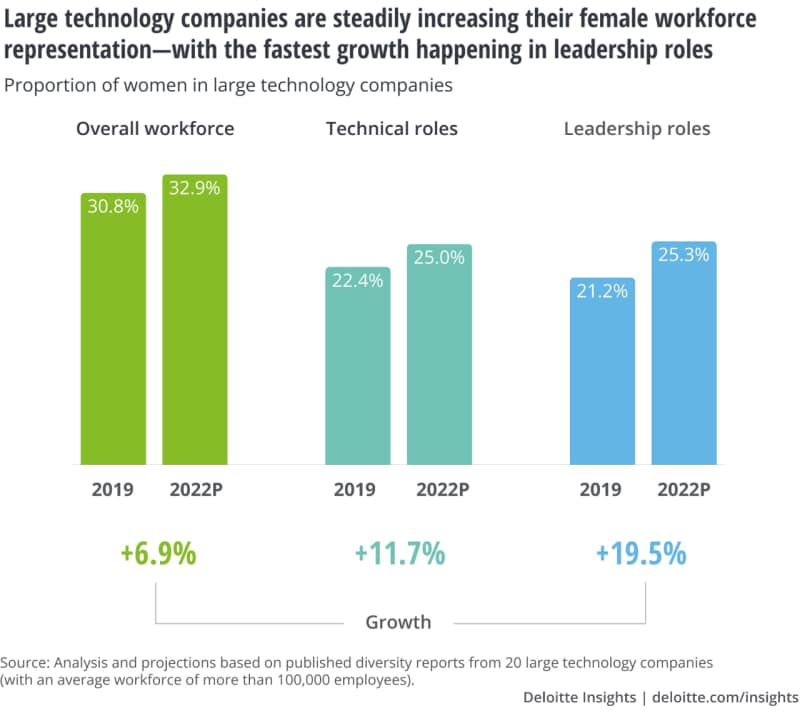Many large tech companies have made public commitments to improving gender diversity, including increasing women in their technical and leadership ranks.5 These companies are also expanding their efforts to ensure greater workforce and leadership diversity by race, age, and other social factors. HP, for example, has pledged to reach 50% gender equality in roles at the director level and above by 2030, and to meet or surpass labor market representation for racial/ethnic minorities.6 Intel aims to double the number of women and underrepresented minorities in senior leadership roles by 2030.7
It makes sense that tech companies are moving the needle on women in leadership faster than women in other roles: It helps send a signal to prospective employees, it helps shift corporate culture, and it may help tech companies increase retention of women in their overall and technical workforces.
Considerations for tech companies
Many tech companies still have much work ahead to diversify their ranks and embrace a greater range of perspectives. Improving gender and other diversity should inspire the same kind of leadership commitment and strategic focus that underlies other critical organizational initiatives.
Commit to a holistic diversity, equity, and inclusion (DEI) strategy. Creating an inclusive culture is essential to recruiting and retaining a diverse workforce. A 2020 study by Lenovo and Intel revealed that a majority of professionals in five countries regard a company’s DEI policies and performance as important considerations in their decisions about jobs to pursue and accept.8 Many large tech companies now release annual diversity reports outlining their strategies and performance. Some have formed a coalition to tackle diversity shortcomings in the tech sector, sharing best practices and lessons learned.9 To improve leadership representation, the members plan to develop guidance for board and executive roles that reflect the customers and communities they serve.10
Embrace goal-setting, transparency, and accountability. It’s critical for tech companies to identify diversity metrics, report results, and track progress. Then organizations can take stock of what is and isn’t working, revise their approach, and improve. Amazon, for example, examines performance ratings and attrition across teams to address any statistically significant demographic differences; the goal is to retain employees at similar rates across demographics.11 A coalition of more than 30 tech company executives, along with academics and DEI experts, has pledged to accelerate DEI progress and collaborated on an Action to Catalyze Tech report; one of the goals is to create industry-wide reporting standards for DEI demographic data.12
Establish creative programs to hire, retain, and promote. Raising a greater proportion of women to leadership roles in techrequires hiring and building a strong bench of female employees—but there are well-known STEM pipeline issues.13 Diversifying the pipeline is a commendable goal but one that will likely take many years of aggressive effort. In the meantime, some tech companies have established apprenticeships that aim to recruit and upskill unconventional talent, such as career-switchers who lack a traditional tech background, and “returnship” programs that provide training and mentorship to women resuming their careers after a pause.14 Companies may be able to improve retention of women and support their advancement to leadership by establishing mentorship programs and development opportunities, along with gender targets for promotions. However, according to Deloitte’s 2021 Women @ Work study, less than a quarter of TMT companies have taken these steps.15














